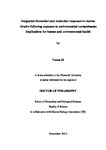Integrated biomarker and molecular responses in marine bivalve following exposure to environmental contaminants: Implications for human and environmental health
| dc.contributor.supervisor | Jha, Awadhesh | |
| dc.contributor.author | Di, Yanan | |
| dc.contributor.other | Faculty of Science and Engineering | en_US |
| dc.date.accessioned | 2013-01-22T12:00:06Z | |
| dc.date.available | 2013-01-22T12:00:06Z | |
| dc.date.issued | 2012 | |
| dc.date.issued | 2012 | |
| dc.identifier | 10048150 | en_US |
| dc.identifier.uri | http://hdl.handle.net/10026.1/1251 | |
| dc.description.abstract |
Environmental genotoxicants/carcinogens in the aquatic environment induce complex detrimental impacts on aquatic organisms. Integrated approach is required to comprehensively assess such impacts in terms of animal and environmental health. Biomarkers at different levels of biological organisations, including clearance rates (at individual level), histopathological alterations (at tissue level), DNA strand breaks using comet assay (at cellular level) and transcriptional alterations of key genes determined by real-time quantitative PCR (at molecular level), were designed and applied to analyse the impacts in marine bivalve: Mytilus sp., a classic bio-indicator species for environmental health monitoring, following exposure to selected environmental contaminants (i.e. Benzo(α)Pyrene (B(α)P), C60 fullerene, and tritium). The performance of biomarkers changed in response to exposures with higher sensitivity for DNA strand breaks and transcriptional alterations of selected genes. In particular, genes representing 7 gene groups (tumour suppressor gene - p53, proto-oncogene - ras, cytochrome P450 family - cyp4y1, MAPKs family - jnk, Bcl-2 family - bax, MDM2 - mdm2 and RAD family - rad51) showed tissue- and chemical-specific expression profiles under selected experimental conditions. A comparison revealed similarity of interplay among these highly conserved genes with mammalian models, suggesting Mytilus sp. could be an ideal model for signalling research in the carcinogenesis process. To my knowledge, this is the first research to detect tissue specific transcriptional alteration of p53 and ras genes in the organism for the analysis of detrimental impacts induced by different environmental genotoxicant/carcinogen exposures. Furthermore, the study is also the first one to include genes which can interplay with each other to function in the regulation of DNA repair, apoptosis and cell cycle arrest in marine organisms. The results suggested that the applied integrated biomarker approach is a comprehensive and sensitive method to monitor environmental health and, marine bivalve Mytilus sp. is an ideal model organism for research on genotoxicant induced carcinogenesis and will shed light on the mechanisms of this complex process in higher organisms, including humans. | en_US |
| dc.language.iso | en | en_US |
| dc.publisher | University of Plymouth | en_US |
| dc.subject | Biomarkers | |
| dc.subject | Gene expression | |
| dc.subject | Mytilus edulis | |
| dc.subject | Human health | |
| dc.subject | Environmental Health | |
| dc.subject | Marine Biology | en_US |
| dc.title | Integrated biomarker and molecular responses in marine bivalve following exposure to environmental contaminants: Implications for human and environmental health | en_US |
| dc.type | Thesis | |
| plymouth.version | Full version | en_US |
| dc.identifier.doi | http://dx.doi.org/10.24382/4118 |
Files in this item
This item appears in the following Collection(s)
-
01 Research Theses Main Collection
Research Theses Main


